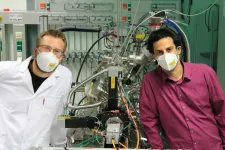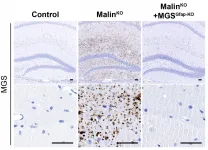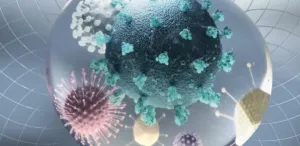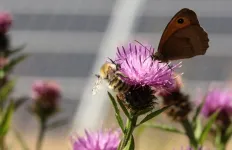INFORMATION:
Review summarizes known links between endocrine disruptors and breast cancer risk
2021-04-20
(Press-News.org) Exposure to certain endocrine-disrupting chemicals could elevate the risk of breast cancer, according to a new comprehensive systematic review of epidemiological research. However, for many chemicals, evidence is inconsistent or still limited. The review was carried out by researchers at the universities of Hong Kong and Eastern Finland and published in Critical Reviews in Food Science and Nutrition.
Endocrine-disrupting chemicals (EDCs) can interfere with the body's hormonal system, also called the endocrine system, and are widely present in the environment. They originate from a variety of sources, including pesticides, plasticisers and other industrial and pharmaceutical chemicals, as well as natural sources. Humans are often exposed to EDCs through food, but other possible exposure routes include drinking water, skin contact and air.
Breast cancer accounts for the majority of women's cancers. There has been an increasing interest in the role of estrogene-mimicking EDCs, so called xenoestrogens, in the development of breast cancer. They comprise a broad range of pesticides, synthetic chemicals, phytoestrogens and certain mycotoxins. The researchers reviewed 131 epidemiological studies evaluating the link between xenoestrogen exposure and breast cancer. Most studies assessed exposures by measuring the EDCs and their metabolites in urine, serum, plasma or adipose tissues.
Some may be genetically more vulnerable to EDCs
According to the review, the nowadays widely banned pesticide DDT is one of the most studied EDCs in relation to breast cancer risk. Out of 43 epidemiological studies, eleven reported positive associations between DDT or its metabolites in lipid, serum or plasma and breast cancer incidence. Nine reported higher DDT levels among women with breast cancer than among controls. In a few studies, DDT was linked to estrogen-positive breast cancer or the association to breast cancer risk depended on genotype.
Polychlorinated biphenyls, PCBs, are a large group of compounds earlier much used in electrical devices, surface coatings and other purposes. The review of 50 studies found the association between total PCBs and breast cancer risk to be inconsistent. However, 19 studies linked certain PCBs to a higher breast cancer incidence. Similar to DTT, PCBs accumulate in the adipose tissue and in the food chain and can be excreted in breast milk.
Perfluorooctanoid acid (PFOA) found in some food packaging and cookware was linked to breast cancer risk in three out of five epidemiological studies. Some studies found an association between cancer risk and certain genotypes both for PCBs and PFOAs.
DDT, PCBs ja PFOA are POP substances, persistent organic pollutants, the use of which is strictly regulated. DDT ja PCBs are old POP substances and their levels in the environment are decreasing. PFOA is a newer POP substance.
Phytoestrogens were found beneficial in some, but not all studies
Phytoestrogens are natural plant estrogens that have been suggested to prevent breast cancer. Genistein is a phytoestrogen found in soy products. The review included 29 epidemiological studies focusing on genistein, 18 of which linked it to a lower breast cancer risk, although some only in certain age groups or populations.
For most EDCs included in the review, the link to breast cancer has been investigated in only a few epidemiological studies. Phtalates and bisphenol A (BPA), for example, are used in plastic packaging and can transfer to food. According to the review, four out of six studies linked phthalates to increased breast cancer risk. BPA was linked to more aggressive tumours in one study, but two other epidemiological studies found no link to breast cancer.
Parabens are common preservatives in foods and cosmetic products and considered possible endocrine disruptors. The only epidemiological study on the topic reported a link between paraben exposures, breast cancer risk and mortality following breast cancer.
Oral contraceptive use was linked to an increased breast cancer risk in seven out of eight epidemiological studies, but there were controversies on how duration or discontinuation of oral contraceptive use affected the risk.
The review also included the herbicide atrazine, the industrial by-product dioxine, mycotoxins produced by food and crop molds, and PBDEs found in household furniture coatings and appliances, but epidemiological studies on their links to breast cancer risk were still scarce and often inconsistent.
The writers point out that for EDCs to disrupt endocrine functions, dose, time, duration and age at exposure all matter. In addition, as multiple EDCs coexist in the environment, more research is needed to evaluate their interactive effects on breast cancer risk.
The review also suggests that genotypes could determine whether EDC exposure affects breast cancer risk, and more research is needed on this topic. "One example is the polymorphism of the CYP1A1 gene, which is responsible for estrogen metabolism."
According to the writers, next-generation technologies, such as genome sequencing, proteomics or epigenomics, can help identify new exposure biomarkers with better sensitivity and specificity. "These technologies will also pave way to better assessment of past exposure and prediction of future risks, by taking into account an individual's genetic profile."
ELSE PRESS RELEASES FROM THIS DATE:
New catalyst for lower CO2 emissions
2021-04-20
If the CO2 content of the atmosphere is not to increase any further, carbon dioxide must be converted into something else. However, as CO2 is a very stable molecule, this can only be done with the help of special catalysts. The main problem with such catalysts has so far been their lack of stability: after a certain time, many materials lose their catalytic properties.
At TU Wien, research is being conducted on a special class of minerals - the perovskites, which have so far been used for solar cells, as anode materials or electronic components rather than for their catalytic properties. Now scientists at TU Wien have succeeded in producing a special perovskite that is excellently suited as ...
"Molecular Tomographer" algorithm maps gene expression in space
2021-04-20
As we accumulate more and more gene-sequencing information, cell-type databases are growing in both size and complexity. There is a need to understand where different types of cells are located in the body, and to map their gene expression patterns into specific locations in tissues and organs. For example, a gene can be actively expressed in one cell while suppressed in another.
One way of mapping genes into tissues is a technique called in situ hybridization. Simply put, a target gene is tagged ("hybridized") with a fluorescent marker within the sections of the tissue it is located in (the "in situ" part). The sections are then visualized under a specialized microscope to see where the gene "lights up". Consecutive photographs of each section are then put together to generate a ...
Scientists at IRB Barcelona discover the cause of neurodegeneration in Lafora disease
2021-04-20
Lafora disease is an inherited neurodegenerative condition that initially develops with seizures in adolescence and evolves with progressive degeneration of the nervous system to death, about ten years after its onset. It is characterised by the accumulation of abnormal glycogen aggregates called Lafora bodies in the brain. There is currently no treatment for this condition, although some therapies are being tested in clinical trials.
Led by Dr. Joan Guinovart, emeritus professor of the University of Barcelona (UB) and also group leader of CIBERDEM, the Metabolic Engineering lab at IRB Barcelona has discovered that Lafora bodies that accumulate in glial cells, which are essential for the proper ...
2D nanomaterial MXene: The perfect lubricant
2021-04-20
You can lubricate a bicycle chain with oil, but what do you do with a Mars rover or a red-hot conveyor belt in the steel industry? Very special nanomaterials have now been studied by the TU Wien together with research groups from Saarbrücken (Germany), Purdue University in the USA and the Universidad de Chile (Santiago, Chile).
The material class of MXenes (pronounced "maxene") has caused quite a stir in recent years in connection with novel battery technologies. But it now turns out that they are also an excellent solid lubricant that is extremely durable and performs its task even under the most difficult conditions. These remarkable properties of MXenes have now been published in the renowned journal ACS Nano.
Like a stack of sheets of paper
Just ...
All-in-one test for COVID-19 surveillance
2021-04-20
A new type of COVID-19 testing strategy could help streamline the process of identifying cases, tracking variants and detecting co-infecting viruses.
At present, separate assays and complex workflows are involved in each of these three diagnostic procedures, with analyses typically performed in highly specialized facilities. KAUST researchers have now combined all three kinds of tests into a single procedure that should allow for point-of-care tracking of COVID-19 and the many emerging variants of SARS-CoV-2.
"Our all-in-one test provides a promising integrated solution for rapid field-deployable detection and mutational surveillance of pandemic viruses," says stem cell biologist Mo Li, who led the study.
The test involves a portable ...
Database developed on key mollusk to study pollution in coastal areas
2021-04-20
Scrobiculariaplana is a type of wedge clam widely found along the coasts and estuariesof northern Europe, the Mediterranean and West Africa. Like other mollusks, it is used as a bioindicator to study pollution in these types of ecosystems, for its ability to accumulate heavy metals and organic pollutants.
A new study has managed to identify the transcriptome and the associated proteome of this bivalve, a finding that could represent an important leap forward in the early detection of pollutants in coastal areas. While the genome is the DNA content comprising the genetic information essential for life, the transcriptome includes only the information on genes that are expressed, while the proteome is the totality of proteins expressed at a given time and under specific conditions. Therefore, ...
Is social media use a potentially addictive behaviour?
2021-04-20
Frequent use of social media may not amount to the same as addiction, according to research at the University of Strathclyde.
The study invited 100 participants to locate specific social media apps on a simulated smartphone screen as quickly and accurately as possible, while ignoring other apps. The participants were varied in the extent and type of their social media use and engagement.
The exercise aimed to assess whether social media users who reported the greatest level of use were more likely to have their attention drawn to the apps through a process known as 'attentional bias,' ...
Ten ways to ensure bees benefit from the solar power boom
2021-04-20
Researchers assessing the impact of solar energy development across Europe have come up with ten ways in which the expansion of solar can be shaped to ensure pollinators benefit.
Space-hungry solar photovoltaic (PV) is set to dominate future global electricity supply, but with careful decision making, efforts to secure clean energy need not come at the expense of biodiversity - particularly pollinators which are in sharp decline.
Bees, hoverflies, wasps, beetles, butterflies and moths play a key role in food production, with around 75% of the leading global food crops and 35% of global crop production relying on them to some extent.
Writing in the journal Renewable and Sustainable Energy Reviews, a Lancaster-led team of environmental scientists systematically reviewed the available ...
URI oceanographers reveal links between migrating Gulf Stream and warming ocean waters
2021-04-20
KINGSTON, R.I., -- April 20, 2021 -- The Northwest Atlantic Shelf is one of the fastest-changing regions in the global ocean, and is currently experiencing marine heat waves, altered fisheries and a surge in sea level rise along the North American east coast. A END ...
How the language you speak aligns to your genetic origins and may impact research on your health
2021-04-20
Almost 80% of South Africans speak one of the SEB family languages as their first language. Their origins can be traced to farmers of West-Central Africa whose descendants over the past two millennia spread south of the equator and finally into Southern Africa.
Since then, varying degrees of sedentism [the practice of living in one place for a long time], population movements and interaction with Khoe and San communities, as well as people speaking other SEB languages, ultimately generated what are today distinct Southern African languages such as isiZulu, isiXhosa and Sesotho.
Despite these linguistic differences, ...






